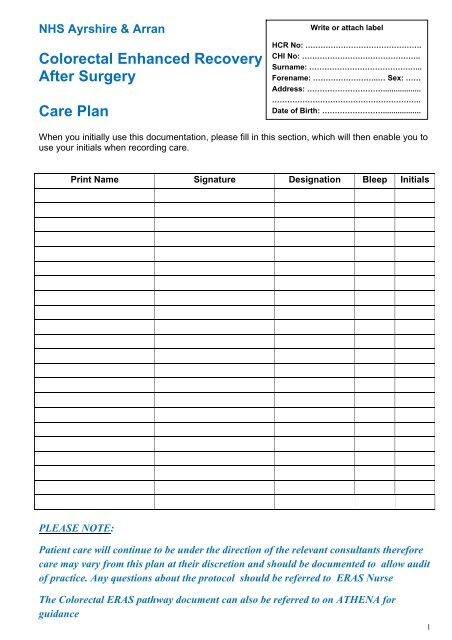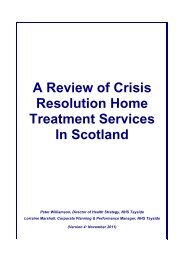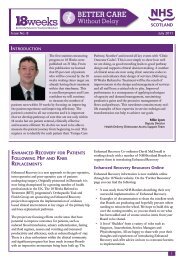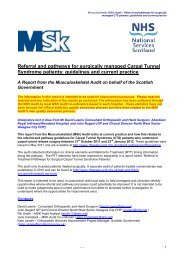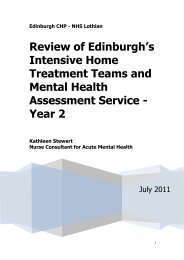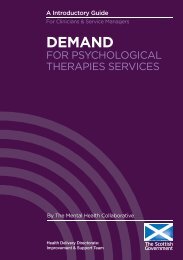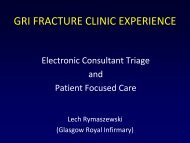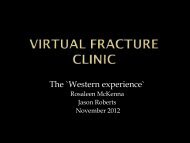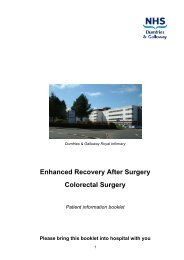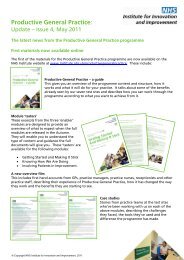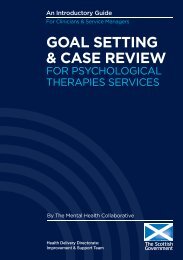Colorectal Enhanced Recovery After Surgery - Care Plan
Colorectal Enhanced Recovery After Surgery - Care Plan
Colorectal Enhanced Recovery After Surgery - Care Plan
You also want an ePaper? Increase the reach of your titles
YUMPU automatically turns print PDFs into web optimized ePapers that Google loves.
NHS Ayrshire & Arran<strong>Colorectal</strong> <strong>Enhanced</strong> <strong>Recovery</strong><strong>After</strong> <strong>Surgery</strong><strong>Care</strong> <strong>Plan</strong>Write or attach labelHCR No: ……………………………………….CHI No: ………………………………………..Surname: ……………………………………...Forename: ……………………..… Sex: ……Address: …………………………..................…………………………………………………..Date of Birth: ……………………..................When you initially use this documentation, please fill in this section, which will then enable you touse your initials when recording care.Print Name Signature Designation Bleep InitialsPLEASE NOTE:Patient care will continue to be under the direction of the relevant consultants thereforecare may vary from this plan at their discretion and should be documented to allow auditof practice. Any questions about the protocol should be referred to ERAS NurseThe <strong>Colorectal</strong> ERAS pathway document can also be referred to on ATHENA forguidance1
Section 1 – Listed for surgeryTo be completed at the surgical out-patient clinic:Consultant: …………………………………..<strong>Plan</strong>ned procedure: ………………………………………..............................................................Pre-op bowel prep details (to be avoided where possible)…………………………………………Special considerations………………………………………………………………………………….…………………………………………………………………………………………………………….Seen by <strong>Colorectal</strong> Specialist NursePre-operative assessment (POA) arrangedDate of POA…………………….Stoma nurse informed of POA dateAdmission day before surgeryProposed date of surgery…………………..Estimated date of discharge………………..Name…………………..Date……………..Signature…………………..………Section 2 – Pre-operative AssessmentTo be completed at Pre-operative Assessment:PLEASE NOTE: the standard pre-operative assessment documentation will co-exist with this documentation.Seen by <strong>Colorectal</strong> Specialist NurseSeen by PhysiotherapistSeen by Stoma NurseSeen by pain control nurse<strong>Colorectal</strong> <strong>Enhanced</strong> <strong>Recovery</strong> Patient Information Pack issuedIf same day admission planned:- Carbohydrate loading drinks issued as below diet/ fasting instructions given(400ml Nutricia pre-op to be taken 2hours and 30mins prior to procedure and consumedwithin 30mins, e.g.6am for 8:30am start in theatre)Outcomes from POA (tick which appropriate):ProceedingProceeding with referral to dieticians (MUST>/=1)Referred for CPET (Age >75, ischaemic heart disease, heart failure, cerebrovascular disease,renal failure , diabetes, reduced exercise tolerance, significant dyspnoea)Referred other (details)……………………………………………………………………………………..………………………………………………………………………………………………………………...Name…………………..Date……………Signature…………………2
Section 3 – Pre-operative PreparationProposed Operation: …………………………………………………………………………….PRE-OPERATIVE DAY this only applies to patients admitted to surgical ward the day before surgeryDate Time Nursing Actions InitialsOrientate to ward / staff and environmentDiscuss management & care plan with patient:Reiterate the importance of nutrition, mobilisation, patients role inrecoveryWith patient’s consent, inform relatives of managementArrange surgical reviewMonitor and document baseline observations and urinalysisEncourage intake of oral fluids until 2 hours pre-op- Approximately 2 litres / 8-10 glasses per day- Clear fluid inc water, cordial, weak black teaAdvise patient to fast from …………..for food………..for fluid (ask anaesthetist).Encourage normal diet until 6 hours prior to planned surgeryIf bowel prep to be given (see front page) give low fibre dietSteamed fish, skinless chicken, eggs, cheese, white bread, butter, white rice orpasta, rich tea biscuits, clear soup, natural yoghurt, tinned peaches or pineappleCarry out any specific instructions from the anaesthetist.Pre-operative sedation will only be used in specific patientsPromote usual mobility, walk along planned postoperative mobilisation routeEnsure TED stockings put on and thromboprophylaxis prescribedEnsure correct identify bracelet is wornHas patient signed consent formJunior doctor actions- Blood results reviewed and documented- Ensure Group and save available- Review ECG- Ensure regular meds prescribed- Ensure DVT prophylaxis prescribed (no later than 8pm)Prescribe carbohydrate loading drinks as below2 cartons (400ml) Nutricia preopto be taken 2hours and 30mins prior to procedure and consumed within30mins, e.g.6am for 8:30am start in theatreAlert surgical or anaesthetic staff to any issues123
Diabetic patientsDiabetic Patients on insulin will usually be admitted the day before surgery . They will require regularblood glucose measurement and insulin therapy to be prescribed by medical staff (See NHS DiabetesGuidelines www.diabetes.nhs.uk)Diabetic patients on insulin are not to be given carbohydrate loading but encouraged to drink400ml water 2 hours and 30mins prior to surgery, which is to be consumed in 30mins.Check with anaesthetist if they wish diabetic patients on oral hypoglycaemic drugs to be givencarbohydrate loading drinks along with their oral hypoglycaemics.SAME DAY ADMISSIONS this will apply only to patients admitted on day of surgeryDate Time Nursing Actions InitialsDiscuss management & care plan with patient:Reiterate the importance of nutrition, mobilisation, patients role inrecoveryFollow any instructions given by surgeon and anaesthetistMonitor and document baseline observations and urinalysisEnsure TED stockings on and thromboprophylaxis prescribed for post opperiodEnsure correct identify bracelet is wornHas patient signed consent formAnaesthetist Actions- Ensure fasting of 6 hours for food and 2 hours for fluid prior to surgery- Ensure carbohydrate loading drinks have been consumed (400mlNutricia pre-op to be taken 2hours and 30mins prior to procedure andconsumed within 30mins, e.g.6am for 8:30am start in theatre)- Blood results reviewed and documented- Ensure Group and save available- Review ECG- Ensure regular meds prescribed- No pre-operative sedation will be used except in very anxious patientsPlease document any pre-operative issues such as reasons for failure to meet any of the PreoperativeERAS elements below:………………………………………………………………………………………………………………………….………………………………………………………………………………………………………………………….………………………………………………………………………………………………………………………….………………………………………………………………………………………………………………………….4
Section 4 – Intra-operative careINTRA-OPERATIVE GUIDANCEThe guidance below is suggested only to guide management aimed at meeting intra-operativeERAS elements for colorectal patients. Actual management will remain at the discretion of thesurgical and anaesthetic teams present in theatre in their assessment of the individual patientsneeds.Surgical AimsConsideration given to transverse Incisions or laparoscopic technique where possibleAvoidance of drains where possibleAvoidance of Nasogastric tubeImmediate Operation Note and postoperative instruction The aim of this record is to aid out ofhours management decisions by staff(To completed by Surgeon; Full Operation should be dictated separately)Operation:Relevant details of Procedure: (Please highlight drains, stomas, anastomoses)Postoperative Instructions (Unless otherwise indicated ERAS care will include. 6 hourly IVHartmann’s, free fluids when patient awake in recovery, protein supplements in HDU, light diet ifdrinks tolerated and mobilisation on the evening of surgery)………………………………………………………………………………………………………………...………………………………………………………………………………………………………………...………………………………………………………………………………………………………………...………………………………………………………………………………………………………………...5
Anaesthetic GuidanceGENERAL• Prophylactic antibiotics within 30 minute period prior to knife to skin guided by local guideline• Thromboprophylaxis: TED stockings, pneumatic compression devices, post-operative subcutaneouslow molecular weight heparin as appropriate• Normothermia maintained using warmed fluids and warmed air blanket.Record temperatures at incision, 2 hours later and end of surgery.• Goal directed fluids monitored by oesophageal Doppler• Urinary catheter• Monitor BM 2 hourly and insulin started if BM > 8ANALGESIAUnless contra-indicated:• Low thoracic epidural for all open procedures and laparoscopic procedures >2 hours in duration- Bolus of up to 15 ml 0.25% levo-bupivacaine and 1 mcg/kg fentanyl.- Infusion of 0.1% levo-bupivacaine and 2 micrograms/ml fentanyl started at 6-16 ml/hr- Prescribe rescue opiate analgesia for use in HDU if epidural sub-optimal• For laparoscopic procedures of less than two hours consider spinal with intrathecal opiates orrectus sheath/TAP blocks.• Avoidance of systemic opiate where possible• Regular paracetamol• Consider NSAIDs and GabapentinINDUCTION/MAINTENANCEUnless contra-indicated:• Use of short acting drugs: Propofol, short-acting opiates, Desflurane, avoidance of nitrous oxide• Dexamethasone 0.1mg/kg (max 8mg) IV at induction and prescribed daily thereafterEND OF SURGERY• Any residual neuro-muscular blockade reversed• Cyclizine 50mg IV/5mins given and prescribed PRN thereafter• Patient at high risk of PONV: Buccastem 3mg given and prescribed PRN thereafter• Prescribe Ephedrine 30mg PO PRN for hypotension secondary to epidural6
Anaesthetic record The aim of this record is to aid out of hours management decisions by staffPremedication used……………………………………………………………………………………Time at start of anaesthetic……………………………..Time at end of anaesthetic……………ASA1 2 3 4 5Monitoring Oesophageal Doppler A line LIDCO Other………………….Epidural Approximate Level …………………Catheter mark at skin…………………..Bolus Levo-Bupivacaine(0.25%) Fentanyl(1mcg/kg)Other…………………Infusion Levo-Bupivacaine(0.1%) Fentanyl(2mcg/kg) Other………………….Induction agent Propofol Fentanyl Vecuronium Other…………………Other analgesia used…………………………………………………………………………………Maintenance anaesthetic Desflurane Propofol Other…………………Intra venous fluidsVolumeNormal Saline5% DextroseHartmann’sGelofusineVolulyteOtherTOTAL INVasopressor required………………………………………………………………………………ESTIMATED TOTAL FLUID OUT Blood……………… Urine……………………Prophylactic Antiemetics: Dexamethasone Cyclizine BuccastemPost-anaesthetic instructions……………………………………………………………………………………………………………….……………………………………………………………………………………………………………….………………………………………………………………………………………………………………..Please document any pre-operative issues such as reasons for failure to meet any of the PreoperativeERAS elements below:……………………………………………………………………………………………………………….……………………………………………………………………………………………………………….7
Section 5 – Post-operative <strong>Care</strong><strong>Colorectal</strong> ERAS Postoperative Symptom AlgorithmsHypotension / Oliguria (MABP
Contact physiotherapy for adviceLocation of post-operative care:Level 1 care as standard, Consider Level 2 for those identified pre-op ashigher risk, Consider ward care for low risk if no epidural usedRECOVERY / DAY 0DATE ………………………...Date Time Nursing Actions Comment InitialsFLUIDSEncourage oral fluid in recovery / Aim for 1000ml oral fluid intakeAim to discontinue iv fluids by following morning if possibleIssues………………………………………………………………..Commence fluid balance chart in recovery areaUrine output of 100ml over last 4 hours acceptable(see hypotension / oliguria algorithm)Hourly urinary volumes only if instructed by surgeon/anaesthetistANTI-EMETICSAssess and treat post-op nausea and vomiting(see nausea & vomiting algorithm)NUTRITIONEnsure patient is given 2 High Protein Drinks 12Commence food chart (see poor oral intake algorithm)MOBILISEMobilise on evening of surgery- Promote deep breathing and limb exercise- Aim for out of bed for 2 hours- Ensure review by physiotherapy(see poor mobility algorithm)ANALGESIARecord Pain Scores and treat pain (see pain-epidural failurealgorithm)Maintenance of epidural for 24-48hours if laparoscopic case,minimum of 48hours for open case (consider replacement in first24hours if problematic)ROUTINE CHECKSObservations to be carried out as follows- ½ hourly for four hours- 1 hourly thereafterHumidified oxygen guided by oxygen saturation (aim >94%)Include wound checksReassess skin integrity and record Waterlow score – carry out9
any necessary action requiredSPECIAL CONSIDERATIONSAssess and document bowel activityCommence stoma care and ensure referral to stoma nurseCarry out daily management plan from ward roundPlease document issues and planned variations from ERASelements below:…………………………………………………………………………………………………………….………………………………………………………………………………………………….If at any time a patient’s symptoms or signs suggest deterioration orsurgical complication then senior surgical review should be requestedimmediately. If a complication is confirmed and level of care is escalatedthen the patient should be withdrawn from this care plan for individualisedmanagement by the surgical team.10
The objective of care is for the patient to eat and mobilise, if this is not beingachieved the underlying issue needs to be addressed.DAY 1 POST OPDATE ………………………Date Time Nursing Actions Comment InitialsFLUIDSDiscontinue iv fluids once > 1litre taken orally ifhaemodynamically stableAim for 2 litres of oral fluids todayUrine output of 100 ml over previous 4 hours is acceptable unlessotherwise documented (see hypotension / oliguria algorithm)ANTI-EMETICSAssess and record post-op nausea and vomiting(see nausea & vomiting algorithm)NUTRITIONAim to restart light diet and give 3 high protein drinks 123Continue food chart(see poor oral intake algorithm)MOBILISEWalks of 60 metres should be encouraged 3 times a day• Walk 1 (to be undertaken by physio team)• Walk 2• Walk 3Aim for out of bed for 8 hours (see poor mobility algorithm)If epidural consider oral ephedrine prior to mobilisationEnsure physiotherapy reviewPromote deep breathing & limb exercisesANALGESIARecord Pain Scores and treat pain (see pain-epidural failurealgorithm)Maintenance of epidural for: 24-48hours if laparoscopic case,minimum of 48hours for open case (consider replacement in first24hours if problematic)ROUTINE CHECKSCheck FBC, U&Es and CRPObservations to be carried out as 1 hourlyHumidified oxygen guided by oxygen saturation (aim >94%)Include wound checks11
Reassess skin integrity and record Waterlow score – carry outany necessary action requiredSPECIAL CONSIDERATIONSRemove any catheters or lines if possibleUrinary catheter to remain in situ if rectal surgery has beencarried out or if epidural remains in placeAssess and document bowel activityStoma care & review by stoma nurse if availableCommence discharge planningReferral to social work or care of the elderly as appropriatePlease document issues and planned variations from ERASelements below:…………………………………………………………………..…………………………………………………………………..…………………………………………………………………..…………………………………………………………………..If at any time a patient’s symptoms or signs suggest deterioration orsurgical complication then senior surgical review should be requestedimmediately. If a complication is confirmed and level of care is escalatedthen the patient should be withdrawn from this care plan for individualisedmanagement by the surgical team.12
The objective of care is for the patient to eat and mobilise, if this is not beingachieved the underlying issue needs to be addressed.DAY 2 POST OPDATE ………………………………...Date Time Nursing Actions Comment InitialsFLUIDSDiscontinue iv fluids once > 1litre taken orally ifhaemodynamically stableAim for 2 litres of oral fluids todayUrine output of 100 ml over previous 4 hours is acceptable unlessotherwise documented (see hypotension / oliguria algorithm)ANTI-EMETICSAssess and record post-op nausea and vomiting(see nausea & vomiting algorithm)NUTRITIONRestart/continue light diet and give 3 high protein drinks 1Continue food chartMOBILISE(see poor oral intake algorithm)Walks of 60 metres should be encouraged 3 times today• Walk 1 (should be undertaken by physiotherapist)• Walk 2• Walk 3Aim for out of bed for 8 hours (see poor mobility algorithm)If epidural consider oral ephedrine prior to mobilisationEnsure physiotherapy reviewPromote deep breathing & limb exercisesANALGESIAIf available ensure Pain Team has reviewed patient- Consideration discontinuation of epidural- Continue regular paracetamolSupplement with NSAID and Oxycodone as appropriate(see pain/epidural failure algorithm)ROTUINE CHECKSCheck FBC, U&Es and CRPObservations to be carried out as clinically indicatedSpecify: …………………………………….Humidified oxygen guided by oxygen saturation (aim >94%)2313
Include wound checksInclude pain scores at least 4 hourlyReassess skin integrity and record Waterlow score – carry outany necessary action requiredSPECIAL CONSIDERATIONSRemove any catheters or lines if possibleUrinary catheter to remain in situ if rectal surgery has beencarried out or if epidural remains in placeAssess and document bowel activityAssess possibility of transfer to general wardStoma <strong>Care</strong> and review by stoma nurse if availableContinue discharge planningReferral to social work or care of the elderly as appropriatePlease document issues and planned variations from ERASelements below:…………………………………………………………………….……………………………………….………………………………………………………………………………………………….…………………………………………………………………….If at any time a patient’s symptoms or signs suggest deterioration orsurgical complication then senior surgical review should be requestedimmediately. If a complication is confirmed and level of care is escalatedthen the patient should be withdrawn from this care plan for individualisedmanagement by the surgical team.Discharge CriteriaAchievedNo requirement of IV fluids for > 24 hrsNo requirement of parenteral analgesia for >24 hrsIndependently mobileBlood tests returning towards normal rangePatient happy to go be dischargedAppropriate home circumstances to discharge patientNo ongoing medical issuesIndependent management of stoma14
The objective of care is to review factors that necessitate hospitalisation: pain,immobility and gut dysfunction and target management to overcome them.DAY 3 POST OPDATE ………………………………...Date Time Nursing Actions Comment InitialsFLUIDSDiscontinue iv fluidsAim for 2 litres of oral fluids todayUrine output of 100 ml over previous 4 hours is acceptableunless otherwise documented(see hypotension / oliguria algorithm)ANTI-EMETICSAssess and record post-op nausea and vomiting(see nausea & vomiting algorithm)NUTRITIONIncrease diet and give 3 high protein drinks 1Continue food chartMOBILISE(see poor oral intake algorithm)Walks of 60 metres should be encouraged 3 times today• Walk 1• Walk 2• Walk 3Aim for out of bed for 8 hours (see poor mobility algorithm)Encourage patient to get dressed todayEnsure physiotherapy reviewPromote deep breathing & limb exercisesANALGEISAIf available ensure Pain Team has reviewed patient- Discontinue epidural- Continue regular paracetamol- Supplement with NSAID and Oxycodone as appropriate(see pain / failed epidural algorithm)ROUTINE CHECKSCheck FBC, U&Es and CRPObservations to be carried out as clinically indicatedSpecify: …………………………………….Humidified oxygen guided by oxygen saturation (aim >94%)Include wound checksInclude pain scores at least 4 hourly2315
Reassess skin integrity and record Waterlow score – carry outany necessary action requiredSPECIAL CONSIDERATIONSRemove any catheters or lines if possibleUrinary catheter can be removed today if rectal surgery oninstruction of consultantAssess and document bowel activityStoma <strong>Care</strong> and review by stoma nurse if availableAssess possibility of transfer to general wardContinue discharge planningReferral to social work or care of the elderly as appropriatePlease document issues and planned variations from ERASelements below:……………………………………………………………………………………………………………….……………………………………………………………………………………………………………………………………………………………………If at any time a patient’s symptoms or signs suggest deterioration orsurgical complication then senior surgical review should be requestedimmediately. If a complication is confirmed and level of care is escalatedthen the patient should be withdrawn from this care plan for individualisedmanagement by the surgical team.Discharge CriteriaAchievedNo requirement of IV fluids for > 24 hrsNo requirement of parenteral analgesia for >24 hrsIndependently mobileBlood tests returning towards normal rangePatient happy to go be dischargedAppropriate home circumstances to discharge patientNo ongoing medical issuesIndependent management of stoma16
The objective of care is to review factors that necessitate hospitalisation: pain,immobility and gut dysfunction and target management to overcome them.DAY 4 POST OPDATE ………………………………...Date Time Nursing Actions Comment InitialsFLUIDSDiscontinue iv fluidsAim for 2 litres of oral fluids todayUrine output of 100 ml over previous 4 hours is acceptable unlessotherwise documented (see hypotension / oliguria algorithm)ANTI-EMETICSAssess and record post-op nausea and vomiting(see nausea and vomiting algorithm)NUTRITIONIncrease diet and give at least 2 high protein drinksIf intake poor continue food chart and refer to dietitianMOBILISEWalks of 60 metres should be encouraged 3 times today• Walk 1• Walk 2• Walk 3Aim for out of bed for 8 hours (see poor mobility algorithm)Encourage patient to get dressed today12Ensure physiotherapy reviewPromote deep breathing & limb exercisesANALGESIAIf available ensure Pain Team has reviewed patient- Discontinue epidural- Continue regular paracetamol- Supplement with NSAID and Oxycodone as appropriate(see pain / failed epidural algorithm)ROUTINE CHECKSCheck FBC, U&Es and CRPObservations to be carried out as clinically indicatedSpecify: …………………………………….Humidified oxygen guided by oxygen saturation (aim >94%)Include wound checksInclude pain scores at least 4 hourly17
Reassess skin integrity and record Waterlow score – carry outany necessary action requiredSPECIAL CONSIDERATIONSRemove any catheters or lines if possibleUrinary catheter can be removed today if rectal surgery oninstruction of consultantAssess and document bowel activityStoma <strong>Care</strong> and review by stoma nurse if availableAssess possibility of transfer to general wardContinue discharge planningReferral to social work or care of the elderly as appropriatePlease document issues and planned variations from ERASelements below:……………………………………………………………………………………………………………….……………………………………………………………………………………………..…………………………………………………………………….If at any time a patient’s symptoms or signs suggest deterioration orsurgical complication then senior surgical review should be requestedimmediately. If a complication is confirmed and level of care is escalatedthen the patient should be withdrawn from this care plan for individualisedmanagement by the surgical team.Discharge CriteriaAchievedNo requirement of IV fluids for > 24 hrsNo requirement of parenteral analgesia for >24 hrsIndependently mobileBlood tests returning towards normal rangePatient happy to go be dischargedAppropriate home circumstances to discharge patientNo ongoing medical issuesIndependent management of stoma18
The objective of care is to review factors that necessitate hospitalisation: pain,immobility and gut dysfunction and target management to overcome them.DAY 5 POST OPDATE ………………………………...Date Time Nursing Actions Comment InitialsFLUIDSDiscontinue iv fluidsAim for 2 litres of oral fluids todayUrine output of 100 ml over previous 4 hours is acceptable unlessotherwise documented (see hypotension / oliguria algorithm)ANTI-EMETICSAssess and record post-op nausea and vomiting(see nausea and vomiting algorithm)NUTRITIONIncrease diet and give at least 2 high protein drinksContinue food chart (see poor oral intake algorithm)Implement nutritional plan recommended by dietitianMOBILISEWalks of 60 metres should be encouraged 3 times today• Walk 1• Walk 2• Walk 3Aim for out of bed for 8 hours (see poor mobility algorithm)Encourage patient to get dressed today12Ensure physiotherapy reviewPromote deep breathing & limb exercisesANALGESIAIf available ensure Pain Team has reviewed patient- Discontinue epidural- Continue regular paracetamol- Supplement with NSAID and Oxycodone as appropriate(see pain / failed epidural algorithm)ROUTINE CHECKSCheck FBC, U&Es and CRPObservations to be carried out as clinically indicatedSpecify: …………………………………….19
Humidified oxygen guided by oxygen saturation (aim >94%)Include wound checksInclude pain scores at least 4 hourlyReassess skin integrity and record Waterlow score – carry outany necessary action requiredSPECIAL CONSIDERATIONSRemove any catheters or lines if possibleUrinary catheter can be removed today if rectal surgery oninstruction of consultantAssess and document bowel activityStoma <strong>Care</strong> and review by stoma nurse if availableAssess possibility of transfer to general wardContinue discharge planningReferral to social work or care of the elderly as appropriatePlease document issues and planned variations from ERASelements below:……………………………………………………………………………………………………………….……………………………………………………………………………………………………………………………………………………………………If at any time a patient’s symptoms or signs suggest deterioration orsurgical complication then senior surgical review should be requestedimmediately. If a complication is confirmed and level of care is escalatedthen the patient should be withdrawn from this care plan for individualisedmanagement by the surgical team.Discharge CriteriaAchievedNo requirement of IV fluids for > 24 hrsNo requirement of parenteral analgesia for >24 hrsIndependently mobileBlood tests returning towards normal rangePatient happy to go be dischargedAppropriate home circumstances to discharge patientNo ongoing medical issuesIndependent management of stoma20
Blood ResultsDateTimeDayUreaCreateGFRNaKCO2CaPO4MgBilALTAlk PGGTAlbHbWCCPltsPTAPPTFibCRPpre-op21
Please detach this page once complete for audit purposesAudit of Outcomes (ERAS nurse to complete)CHI SEX SurgeonProcedure LAP / OPENOut Come Yes No Comments<strong>Surgery</strong> date as plannedSame day admissionPre-op education deliveredCarbohydrate LoadingBowel prep omitted<strong>Surgery</strong> as plannedGoal directed fluid replacement intra-operativelyCatheter removed as plannedIVI removed as plannedEpidural removed as plannedMobilisation as plannedEarly Nutrition as plannedIndependently Mobile Record day post op =1 st Bowel function Record day post op =Diet commenced Record day post op =Stoma education as plannedIndependent by day ……………..post-opPatient completed diary as planDischarge date as predictedLength of stay = ……………………………………………………………..23
Post- Operative Complications (ERAS nurse to complete)during stay / causing delayed discharge/complication Day/date Day/dateUrinary tract infectionReadmittedWound infectionPeritonitisMain causeAbdominal abscessPost-op dayChest infectionNo. of nights in hospitalOther sig. InfectionPost-op bleedingRe-operatedWound dehiscenceProlonged IleusCause of re-opPost-op day of re-opDeep vein thrombosisPulmonary embolismDeathCardiac failureMyocardial infarctionPost-op day of deathStrokeCause of deathRespiratory failureAcute renal failureLiver dysfunctionSevere / moderate / mildUnplanned ICU admission24


